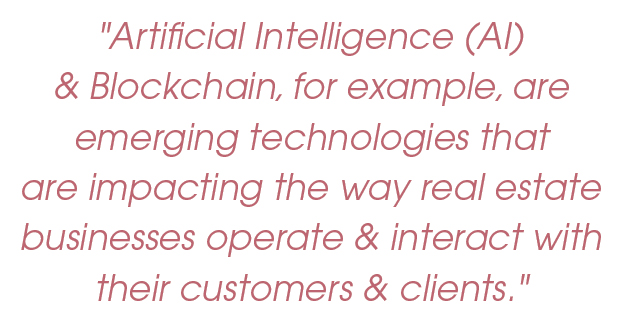
For the first time in NAWRB history, this sheCENTER(FOLD) features not just one woman but a collage of dynamic “Essential Women” who are impacting the well being of society through these difficult times. After asking our community for submissions, we are incredibly humbled to give center stage to a few of these women leaders, representing a variety of positions and backgrounds, who are helping to ensure the quality of life of countless Americans as we tackle the corona virus (COVID-19) as a united front. These women are having a positive impact on the world, even if their actions are unseen and unheard. NAWRB gives voice to their selfless actions and sheds light on their efforts to show these women that they are being noticed and appreciated. Continue reading

 Login
Login




















 Innovators are working to make AI great at problem-solving, automatic processing, data collecting and so on, but being an agent or broker requires skills AI does not have: the expert advice of a professional who has worked in the field for over 20 years, the ethics to makes sure AI is used responsibly, the ability to listen and understand a client’s needs, the intuition to know when a property is a good fit or deal, and the empathy to sympathize and provide moral support when homebuyers get cold feet or things don’t go according to plan.
Innovators are working to make AI great at problem-solving, automatic processing, data collecting and so on, but being an agent or broker requires skills AI does not have: the expert advice of a professional who has worked in the field for over 20 years, the ethics to makes sure AI is used responsibly, the ability to listen and understand a client’s needs, the intuition to know when a property is a good fit or deal, and the empathy to sympathize and provide moral support when homebuyers get cold feet or things don’t go according to plan.

 When you have an opportunity to take a good, long look at the ocean along the California coast, you will very likely see surfers and dolphins riding waves, whale spouts or breaches, and ships on the horizon. What you do not see are the fish and deep sea corals that are the very foundation of a healthy ocean, and feeding ground for the whales, dolphins and sea birds. Nor do you see the towering kelp forests off the coast that are home to over 1,000 species of animals and plants, and rocky reefs that explode with marine critters from elusive sharks to the endangered black sea bass.
When you have an opportunity to take a good, long look at the ocean along the California coast, you will very likely see surfers and dolphins riding waves, whale spouts or breaches, and ships on the horizon. What you do not see are the fish and deep sea corals that are the very foundation of a healthy ocean, and feeding ground for the whales, dolphins and sea birds. Nor do you see the towering kelp forests off the coast that are home to over 1,000 species of animals and plants, and rocky reefs that explode with marine critters from elusive sharks to the endangered black sea bass.

 ERIN O’Toole,
ERIN O’Toole,  Kellie Aamodt, Board Member of Marine Applied Research & Exploration (MARE), and Former UPS, VP of Corporate Inside Sales
Kellie Aamodt, Board Member of Marine Applied Research & Exploration (MARE), and Former UPS, VP of Corporate Inside Sales 
 Business owners and travelers can purchase insurance policies for unforeseen cancellations, yet very few, if any, have clauses about pandemic coverage as this situation is unprecedented. It is resulting in a substantial revenue loss for businesses who depend on the funds from renting out their properties to pay their mortgage and make other necessary payments, or as a source of passive income. In addition, many short-term rental businesses are seeing loss in potential revenue as less people are booking stays for peak seasonal travel times, including holidays, both domestically and internationally, when hosts make most of their revenue.
Business owners and travelers can purchase insurance policies for unforeseen cancellations, yet very few, if any, have clauses about pandemic coverage as this situation is unprecedented. It is resulting in a substantial revenue loss for businesses who depend on the funds from renting out their properties to pay their mortgage and make other necessary payments, or as a source of passive income. In addition, many short-term rental businesses are seeing loss in potential revenue as less people are booking stays for peak seasonal travel times, including holidays, both domestically and internationally, when hosts make most of their revenue. “Reservations made on or before March 14, 2020 for stays and Airbnb Experiences, with a check-in date between March 14, 2020 and April 14, 2020, are covered by the policy and may be cancelled before check-in. Guests who cancel will receive a full refund, and hosts can cancel without charge or impact to their Superhost status. Airbnb will refund all service fees for covered cancellations. The host’s cancellation policy will apply as usual to reservations made after March 14, 2020, and to reservations made on or before March 14, 2020 with check-in dates after April 14, 2020.”
“Reservations made on or before March 14, 2020 for stays and Airbnb Experiences, with a check-in date between March 14, 2020 and April 14, 2020, are covered by the policy and may be cancelled before check-in. Guests who cancel will receive a full refund, and hosts can cancel without charge or impact to their Superhost status. Airbnb will refund all service fees for covered cancellations. The host’s cancellation policy will apply as usual to reservations made after March 14, 2020, and to reservations made on or before March 14, 2020 with check-in dates after April 14, 2020.”

 When you purchase an item, the “Terms and Conditions” of the contract become invalid if you misuse or abuse the item. People are the same way. They will not support the leader if the “Terms and Conditions” of their employment have been abused. Leaders must consciously consider how their daily interactions impact the psychological “Terms and Conditions” that their people have with them. If they do not consider this, they will be ineffective leaders at some point.
When you purchase an item, the “Terms and Conditions” of the contract become invalid if you misuse or abuse the item. People are the same way. They will not support the leader if the “Terms and Conditions” of their employment have been abused. Leaders must consciously consider how their daily interactions impact the psychological “Terms and Conditions” that their people have with them. If they do not consider this, they will be ineffective leaders at some point. Preparation and care must precede the giving of the message. Too often leaders will serve a bad message and later say, “Well, he or she didn’t listen!” Leaders need to consider that when they delivered their message indigestion was delivered as well. Clarity checks are important and it is necessary to ask a few questions of the audience to ensure understanding. This will validate the message and determine whether it tasted good, or if it gave your people indigestion.
Preparation and care must precede the giving of the message. Too often leaders will serve a bad message and later say, “Well, he or she didn’t listen!” Leaders need to consider that when they delivered their message indigestion was delivered as well. Clarity checks are important and it is necessary to ask a few questions of the audience to ensure understanding. This will validate the message and determine whether it tasted good, or if it gave your people indigestion.





